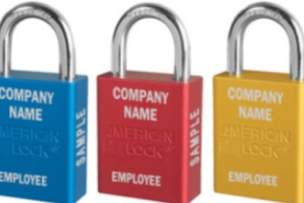Lockout/Tagout Procedure Tips: Authorized vs. Affected Employees
Authorized and affected employees face different levels of risk from hazardous energy, so there are different safety requirements for each.
Lockout/tagout procedures required by OSHA help keep shop employees safe from the uncontrolled release of hazardous energy. But for the procedures to work properly, workers need to know which category of employee they are—affected or authorized.
Authorized and affected employees both play a role in controlling hazardous energy—making sure machines can’t be turned on when they’re being serviced or when maintenance is being performed. The Occupational Safety and Health Administration’s standard for lockout/tagout (CFR 1910.147) lays out the minimum requirements for controlling hazardous energy in general industry and includes details on responsibilities for both types of employees.
“By ensuring that both the affected and authorized employees know their respective roles during lockout/tagout, the safety of all the employees will be greatly increased,” mechanical engineer Dana Andersen writes for ESC Services.
The OSHA Lockout/Tagout Standard for Authorized and Affected Employees
OSHA’s lockout/tagout standard describes in detail the procedures facilities should have in place for controlling hazardous energy, as well as when and how the procedures should be implemented.
The standard generally requires employers to put procedures in place to ensure machines are isolated from the energy sources that drive them when they are being serviced or maintained and their unexpected energization, startup or release of stored energy could cause employee injuries.
OSHA offers these definitions:
What Are Affected Employees?
An employee whose job requires him/her to operate or use a machine or equipment on which servicing or maintenance is being performed under lockout or tagout, or whose job requires him/her to work in an area in which such servicing or maintenance is being performed.
What Are Authorized Employees?
A person who locks out or tags out machines or equipment in order to perform servicing or maintenance on that machine or equipment. An affected employee becomes an authorized employee when that employee’s duties include performing servicing or maintenance covered under this section.
Lockout/Tagout Procedure: What Is an Affected Employee?
“Affected employees are those employees that are affected by a lockout,” says Andersen. “Their work involves the equipment that is being locked out, and their job will be affected during the lockout.” Examples of an affected employee include an operator not authorized to lock out equipment or an office worker whose heating or air conditioning unit is being worked on, says Andersen.
Affected employees are not in charge of lockout/tagout procedures themselves, but they could be injured if the procedure isn’t followed correctly.
“This is the employee that might not have as much control over the situation, but in some circumstances, might get just as injured or ill from exposure to hazards,” says Kirstie Chisholm, e-learning manager at Safety Compliance Management. “They are not in charge or handling the hazard, so they may not be able to control it or provide themselves with appropriate protection from the hazard.”
Lockout/Tagout: What Is an Authorized Employee?
In contrast to affected employees, authorized employees are responsible for implementing the lockout/tagout procedures in the company’s safety plan.
“An authorized employee is an employee, such as a maintenance mechanic, who has had proper training and is allowed to lock out equipment,” says Andersen. “Authorized employees can be affected; however, affected employees cannot be authorized employees unless they have received proper training.”
According to the OSHA regulation, authorized employees are responsible for informing affected employees about lockouts and tagouts—both when locks and tags are placed and when they are removed. They can remove only the locks and tags that they affixed to equipment, not locks or tags used by other authorized employees.
Authorized employees conduct periodic inspections of the company’s energy control procedure. However, the standard states, the authorized employee must not be the same one using the energy control procedure being inspected. The inspector reviews each employee’s responsibilities under the procedure with each authorized employee. For tagout processes, the review must also include affected employees.
“By ensuring that both the affected and authorized employees know their respective roles during lockout/tagout, the safety of all the employees will be greatly increased.”
How to Train Affected and Authorized Employees in Lockout/Tagout
J. J. Keller says training programs for LOTO procedures need to cover at least four areas:
- The employer’s energy control program
- The elements of the energy control procedures that are relevant to the employee’s duties
- The restrictions of the program applicable to each employee
- The requirements of the standard
“The details will necessarily vary from workplace to workplace, and even from employee to employee within a single workplace, depending upon the complexity of the equipment and the procedure, as well as the employee’s duties and their responsibilities under the energy control program,” J. J. Keller says.
Need help with lockout/tagout training? Read “4 Must-Answer Questions to Help Your Lockout/Tagout Training Program.”
According to OSHA, authorized employees need to be trained to recognize hazardous energy sources, the type and magnitude of the energy available, and the methods and means needed for isolating and controlling that energy. Affected employees, on the other hand, only need to be trained to know the purpose and use of LOTO procedures.
In addition, both authorized and affected employees must be retrained whenever there is:
- A change in their job assignments
- A change in machines, equipment or processes that present a new hazard
- A change in the energy control procedures
Retraining should also take place if any employee demonstrates a gap in the knowledge of the LOTO procedures.
Heather Hunt at L&D Daily Advisor writes that though the training requirements differ for authorized and affected employees, training can take place at the same time.
“You may train them together as long as you cover both areas and clearly state to the ‘affected’ employees that they are not authorized to perform any of the duties of an ‘authorized’ employee,” she says.
MSC can help you create a safer workplace to keep your team protected from electrical hazards. For a FREE assessment, training, programs and products to keep safe, visit mscdirect.com.
CLICK HERE to explore product solutions that help maintain a safer workplace and check out MSC's Safety Guide Book for more even tips.





Talk to Us!
Can affected employees go in to a machine and clean it if the machine is lockout and tag out? or does the affected employee then become the authorized employee and must be trained as such? Thank you.
112I have seen what happens when people don't follow lock out tag out Death and sever injuries. Working in refineries and HAZ MAT OIL FIELDS
382Please call me at 386 341 7335
370Done
75Do both employees working on the machine have to have locks on the lock out
76How does an affected employee indicate that a piece of equipment is in need of repair and protect their coworkers if they can not place a lock or tag on the defective equipment ? What do they do until the authorized employee shows up. We have no authorized employees. All are outside maintenance companies we call when something breaks. ( like a forklift )
56adasd
57Leave a reply
Your email address will not be published. Required fields are marked *